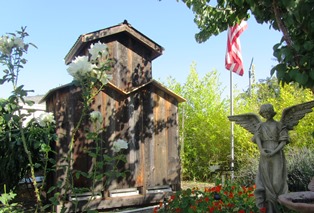Building A Honeybee House
For my birthday this year, my husband surprised me with some practical beekeeping gifts and a promise to build an attractive bee house to hold our hives. In a plastic, five-gallon honey bucket, he’d placed a beekeeper’s suit, goatskin gloves, and a smoker.
This weekend, he made good on his promise. Although the temps hit 85 on Saturday and Sunday, he suited up in a lightweight beekeeper’s topper with protective netting over the face and got to work measuring, cutting, and securing the waterproofing material, hammering it in place.
With the waterproofing material attached to the roof and sides, he then covered the structure with old fence boards. But it wasn’t easy to mark the cut lines wearing gloves much less cutting the boards with the arm and table saws. He peeled the gloves off.

Beekeeper access is through the rear; the upper story holds a supply shelf; bee entrances are at the front bottom
Now, I know one thing about honeybees. Knocking at their door (say, with a hammer) will bring the guards out and they’ll sting . . . which they did.
My husband was on a mission and wasn’t about to let a bee sting stop him. He rubbed the spot with an ice cube, refused to take any Benadry®, and returned to work. But, not before donning some gloves.
But the gloves he put on weren’t beekeeping gloves. They were gardening gloves, good for deadheading roses but not much of a defense against venom-filled stingers.
So, for a little additional insurance against any more bee stings, we lit the smoker to calm the bees a bit. My husband was nearly finished working around the entrance to the hive when one of the honeybees apparently took notice of the fabric portion of the glove and stung right through it.
Even then, Carlos didn’t want to stop working. Only two metal roof sections remained to be cut, placed, and secured along with a shelf for the supplies. But it was sunset. The bees were going in for the night, and we were working in their flight path. We decided to call it a day, too.
The bee house roof will need to be finished before the rainy season starts in November. The good news is that the bees won’t bother Carlos if he stays in back of their house or on the roof. Activity at their front door sends an alarm through the entire colony that a predator is trying to get in. The honeybee defense is to go into attack mode, even if the “predator” in this case is the architect who designed and built their darling little house.
Tags: beekeeper supplies, honeybee house, metal roof, predator, stingers, venom
 Facebook
Facebook Goodreads
Goodreads LinkedIn
LinkedIn Meera Lester
Meera Lester Twitter
Twitter





